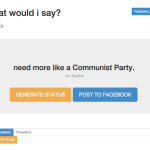Chat Bots and Big Data – Hyperallergic

OAKLAND, Calif. — With our data-driven lives, so much of what we do can be seen through the lens of algorithms. One algorithm can predict if your relationship will fail by using your Facebook data. Another can anticipate movie profits thanks to tweet patterns. There’s one for predicting red light runners based on the car’s rate of deceleration. Or even when you’ll get sick.
What Would I Say?, a Facebook app that’s been making the rounds recently, takes the predictive ability enabled by lots of data and generates your next status. Produced out of hack day at Princeton, the posts the project generates are eerily human-sounding, a bot-cum-doppelganger that traverses the uncanny valley with your social media data.
Here are a few I got:
“It’s still not food here? Me Yes.”
“Many thanks for compelling examples I’ve read Korean!”
“Did you get it was reference during the winter.”
Sound like me? Of course it does. Other services, like Twitov, do the same thing based on your Twitter data. It’s an odd effect.
These projects are strange reflection of a reality where Twitter bots steal other people’s identities and bios to create the semblance of real human beings. After all, even the most robotic chatbot is based on a human being’s creative act.
Internet culture writer Joanne McNeill explored something like this when she set up her own MyCyberTwin, a chatbot based on her own writing style and personality. It was an exploration of different styles and mediums of communication online, but in the act of constructing the bot, she noted that conversations online aren’t just about faithfulness to text. They’re also about personality and behavior:
Accuracy isn’t the only objective while writing scripts for the bot to follow. Duration of amusement is just as important. I don’t want to bore friends to “brb” after too many canned-sounding answers. So I focused more on creating questions for participants rather than answers and statements of mine.
Composing responses, I was inspired by interactive fiction writing like Zork, which deals with the intuitive nature of participants. A good IF writer knows how to tell a story so a user’s command like “get lamp” is signaled somewhere in the text, likewise, the reader is engaged enough to want to continue.
As much as I find algorithms interesting, I do think that these qualitative experiences have another value. In the age of metadata spying and big data sweeps, simple chat generators like these help bring home just how much power there is behind large sets of data. But they’re also a reminder, of course, of data’s limitations.
Subscribe to the Hyperallergic newsletter!
Originally posted here:
Chat Bots and Big Data – Hyperallergic

